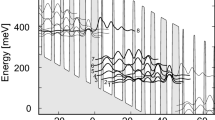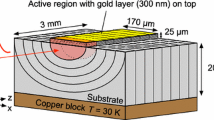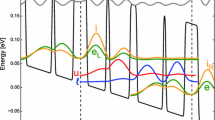Abstract
We describe the inclusion of nonequilibrium gain into a self-consistent 2.5D CW spectral laser diode model and report on the use of this model to investigate the origin of gain compression in a 975 nm high-brightness tapered QW laser diode. Nonequilibrium gain is calculated using a dynamic gain model, which simulates the dynamic relaxation of the quantum well carrier energy distributions under the influence of steady-state electrical and optical excitation. Calculated gain and spontaneous emission spectra are included in the laser model via parameterised look up tables. Both simulated and experimentally measured intracavity spontaneous emission spectra show an increased carrier density and a blue-shift of the gain maximum with increasing bias caused by carrier heating and spectral hole burning. The accurate incorporation of nonequilibrium gain compression is therefore vital for the accurate prediction of the operating characteristics of these devices and for the experimental determination of the active region temperature.
Similar content being viewed by others
References
Agrawal G.P. (1984). J. Appl. Phys. 56:3100
Bream, P.J., S. Sujecki and E.C. Larkins. Semiconductor and Integrated Optoelectronics (SIOE) conference. Cardiff, April, 2006.
Bull S., Andrianov A.V., Wykes J.G., Lim J.J., Sujecki S., Auzanneau S.C., Calligaro M., Lecomte M., Parillaud O., Krakowski M., Larkins E.C. (2005). IEE Proc. Optoelectron. 153:2
Casey Jr. H.C., Panish M.B. (1978) Heterostructure Lasers Part A: Fundamental Principles. Academic Press Inc., London
Fukuda M. (1999) Optical Semiconductor Devices. John Wiley & Sons, Inc., New York
Hadley G.R. (1992). Opt. Lett. 17:1743
Kaminow I., Li T. (eds) (2002) Optical Fiber Telecommunications. Academic Press, San Diego
Kazarinov R.F., Henry C.H., Logan R.A. (1982). J. Appl. Phys. 53:4631
Lim J.J., Benson T.M., Larkins E.C. (2005). IEEE J. Quantum Electron. 41:506
Ramanujan S., Winful H.G. (1996). IEEE J. Quantum Electron. 32:784
Saleh B.E.A., Teich M.C. (1991) Fundamentals of Photonics. John Wiley & Sons, Inc., Toronto
Sujecki S., Borruel L., Wykes J.G., Moreno P., Sumpf B., Sewell P., Wenzel H., Benson T.M., Erbert G., Esquivias I., Larkins E.C. (2003). IEEE J. Select. Topics Quantum Electron. 9:823
Author information
Authors and Affiliations
Corresponding author
Rights and permissions
About this article
Cite this article
Bream, P.J., Lim, J.J., Bull, S. et al. The impact of nonequilibrium gain in a spectral laser diode model. Opt Quant Electron 38, 1019–1027 (2006). https://doi.org/10.1007/s11082-006-9017-9
Received:
Accepted:
Published:
Issue Date:
DOI: https://doi.org/10.1007/s11082-006-9017-9




